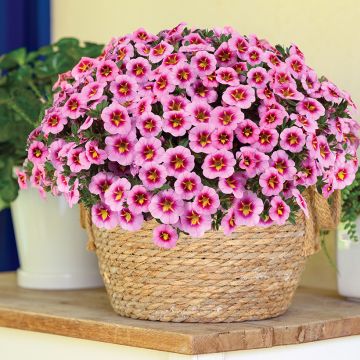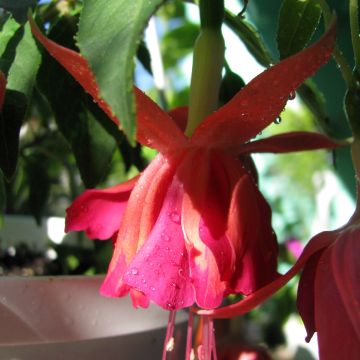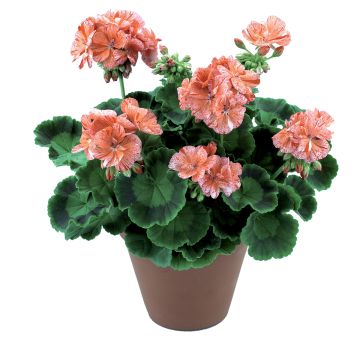

Calibrachoa Eyeconic Purple - Mini-Petunia
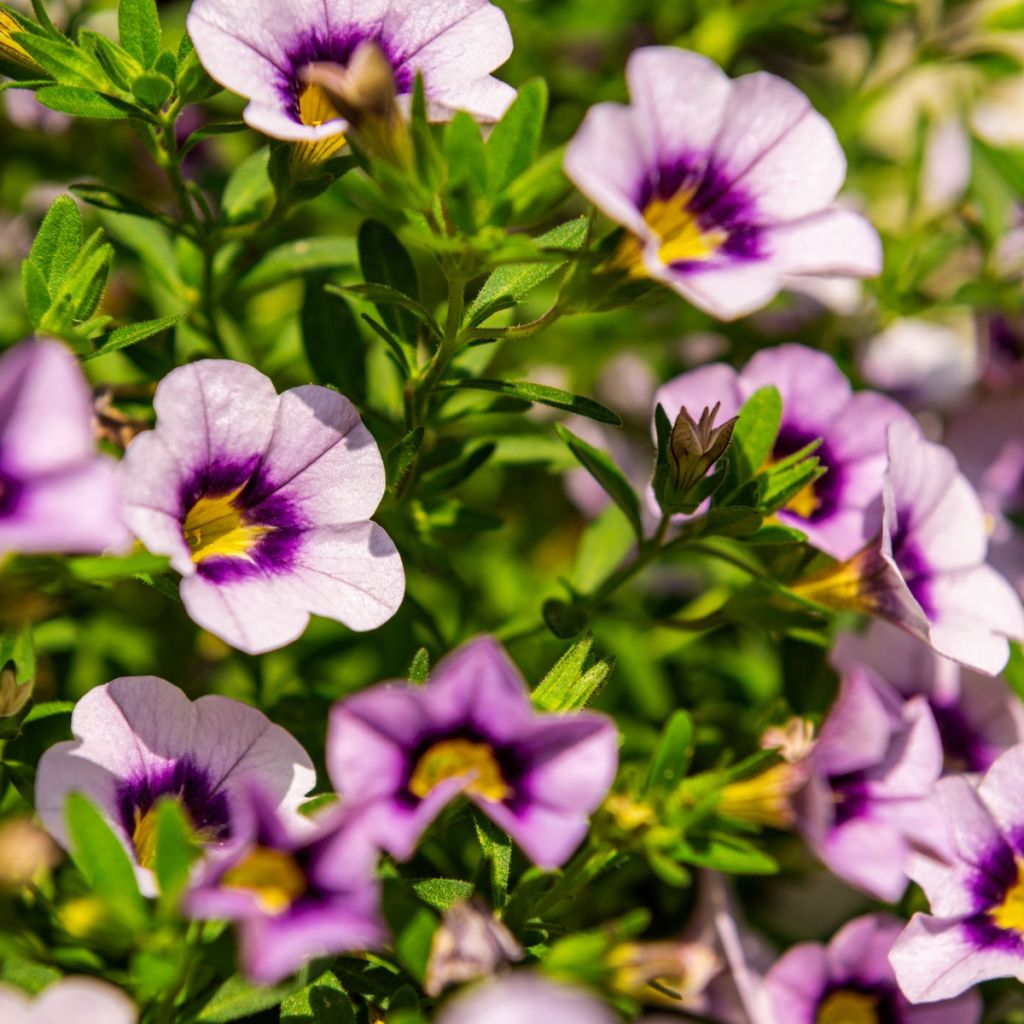

Calibrachoa Eyeconic Purple - Mini-Petunia
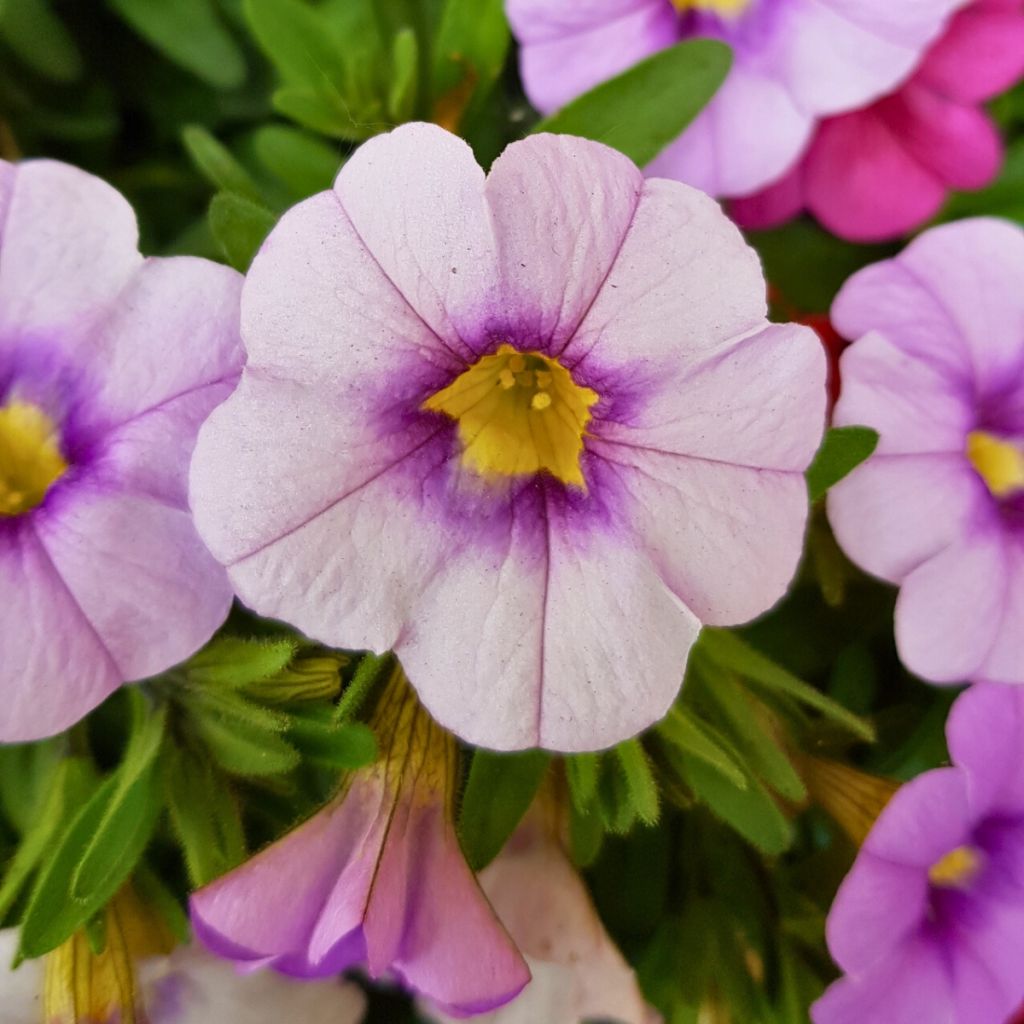

Calibrachoa Eyeconic Purple - Mini-Petunia
Calibrachoa Eyeconic Purple - Mini-Petunia
Calibrachoa hybrida Eyeconic Purple
Mini-pétunia
This item cannot be shipped to the selected country
Delivery charge from €5.90
More information
Schedule delivery date,
and select date in basket
This plant carries a 6 months recovery warranty
More information
We guarantee the quality of our plants for a full growing cycle, and will replace at our expense any plant that fails to recover under normal climatic and planting conditions.
From €5.90 for pickup delivery and €6.90 for home delivery
Express home delivery from €8.90.
Does this plant fit my garden?
Set up your Plantfit profile →
Description
The Calibrachoa Eyeconic Purple is part of a series of quite spectacular Mini-Petunias that produce generous sized blooms with remarkably contrasting colours, which remain open from morning to evening. Eyeconic Purple Calibrachoas bear abundant pale mauve flowers with a violet throat on very pretty cushion-shaped plants. Floriferous, exotic, and colourful, this Calibrachoa creates a sensation in hanging baskets and flower pots throughout the summer. It is a generous annual that is very easy to grow in the sun, in any light, fertile soil that is not too dry.
Calibrachoa, sometimes called Million Bells, are frost-sensitive perennial plants often grown as annuals. Very similar to Petunias, they differ in the number of chromosomes that make up their genetic heritage and some morphological characteristics: their flowers are smaller, their growth habit is shrub-like or herbaceous with woody stems, their development is less significant, and they tolerate drought better. The hybrids that make up this group all belong to the solanaceae family (like tomatoes) and probably descend from an Argentinian species called Petunia integrifolia.
The 'Eyeconic Purple' variety quickly forms a dense dome that is wider than it is tall, reaching a height of 30 cm (1 ft) and a diameter of 35-40 cm (13.8 - 15.7 in). Its flexible stems are densely covered with small, persistent, fuzzy, and slightly sticky lanceolate leaves of a medium green colour. It flowers tirelessly from June until the first frosts. Numerous solitary funnel-shaped, pale mauve flowers about 4 cm (1.6 in) wide arise from the axil of the leaves, surrounding a tiny golden yellow throat encircled by a wide violet ring. Unlike Petunias, these Calibrachoa plants do not need to be pruned or pinched during the season.
The Calibrachoa 'Eyeconic Purple' is ideal for hanging baskets, planters, or pots, but its heat and drought tolerance as well as its vigour, also allow it to be used in the ground, where it forms very pretty borders and spots of intense colour in flower beds. It can be planted alone or accompanied by 2 or 3 other varieties with complementary colours (pink, yellow, white), in vases, flower pots, planters on terraces, balconies, or patios. Calibrachoas are also good veranda plants. Their combination with verbenas, surfinia petunias, double bacopas, and nemesias is stunning. The choice is vast and allows for imagination and the tastes of every gardener, even inexperienced ones.
Please note: our young plants in mini-pots are professional products intended for experienced gardeners: upon receipt, transfer and store them under cover (veranda, greenhouse, cold frame...) at a temperature above 14C° (>57.2 F) for a few weeks before planting outdoors once the risk of frosts has definitively passed.
Report an error about the product description
Calibrachoa Eyeconic Purple - Mini-Petunia in pictures




Flowering
Foliage
Plant habit
Botanical data
Calibrachoa
hybrida
Eyeconic Purple
Solanaceae
Mini-pétunia
Cultivar or hybrid
Other Calibrachoa or Mini-petunia
Planting and care
You can plant your Calibrachoa Eyeconic Purple in the ground or in pots. If you wish to plant them in the ground, wait until the last heavy frosts have passed. In the meantime, you can pre-cultivate them in a warm and bright place to accelerate their growth. Calibrachoas will flower from June to October. Plant your Calibrachoas in a sunny location protected from the wind. They need a light and humus-rich, but above all, well-drained soil. Do not over-water them at the beginning of the growing season as they are sensitive to excessive moisture. They tolerate drought well but will need regular watering during hot summer weather. Very floriferous and fast-growing, they are hungry plants. We recommend feeding them with a liquid fertiliser for Surfinias once or twice a week during the growing season. Remove faded flowers and dry leaves as they appear to keep them looking good and extend the flowering period.
Planting period
Intended location
Care
This item has not been reviewed yet - be the first to leave a review about it.
Plug plants - Annuals
Haven't found what you were looking for?
Hardiness is the lowest winter temperature a plant can endure without suffering serious damage or even dying. However, hardiness is affected by location (a sheltered area, such as a patio), protection (winter cover) and soil type (hardiness is improved by well-drained soil).

Photo Sharing Terms & Conditions
In order to encourage gardeners to interact and share their experiences, Promesse de fleurs offers various media enabling content to be uploaded onto its Site - in particular via the ‘Photo sharing’ module.
The User agrees to refrain from:
- Posting any content that is illegal, prejudicial, insulting, racist, inciteful to hatred, revisionist, contrary to public decency, that infringes on privacy or on the privacy rights of third parties, in particular the publicity rights of persons and goods, intellectual property rights, or the right to privacy.
- Submitting content on behalf of a third party;
- Impersonate the identity of a third party and/or publish any personal information about a third party;
In general, the User undertakes to refrain from any unethical behaviour.
All Content (in particular text, comments, files, images, photos, videos, creative works, etc.), which may be subject to property or intellectual property rights, image or other private rights, shall remain the property of the User, subject to the limited rights granted by the terms of the licence granted by Promesse de fleurs as stated below. Users are at liberty to publish or not to publish such Content on the Site, notably via the ‘Photo Sharing’ facility, and accept that this Content shall be made public and freely accessible, notably on the Internet.
Users further acknowledge, undertake to have ,and guarantee that they hold all necessary rights and permissions to publish such material on the Site, in particular with regard to the legislation in force pertaining to any privacy, property, intellectual property, image, or contractual rights, or rights of any other nature. By publishing such Content on the Site, Users acknowledge accepting full liability as publishers of the Content within the meaning of the law, and grant Promesse de fleurs, free of charge, an inclusive, worldwide licence for the said Content for the entire duration of its publication, including all reproduction, representation, up/downloading, displaying, performing, transmission, and storage rights.
Users also grant permission for their name to be linked to the Content and accept that this link may not always be made available.
By engaging in posting material, Users consent to their Content becoming automatically accessible on the Internet, in particular on other sites and/or blogs and/or web pages of the Promesse de fleurs site, including in particular social pages and the Promesse de fleurs catalogue.
Users may secure the removal of entrusted content free of charge by issuing a simple request via our contact form.
The flowering period indicated on our website applies to countries and regions located in USDA zone 8 (France, the United Kingdom, Ireland, the Netherlands, etc.)
It will vary according to where you live:
- In zones 9 to 10 (Italy, Spain, Greece, etc.), flowering will occur about 2 to 4 weeks earlier.
- In zones 6 to 7 (Germany, Poland, Slovenia, and lower mountainous regions), flowering will be delayed by 2 to 3 weeks.
- In zone 5 (Central Europe, Scandinavia), blooming will be delayed by 3 to 5 weeks.
In temperate climates, pruning of spring-flowering shrubs (forsythia, spireas, etc.) should be done just after flowering.
Pruning of summer-flowering shrubs (Indian Lilac, Perovskia, etc.) can be done in winter or spring.
In cold regions as well as with frost-sensitive plants, avoid pruning too early when severe frosts may still occur.
The planting period indicated on our website applies to countries and regions located in USDA zone 8 (France, United Kingdom, Ireland, Netherlands).
It will vary according to where you live:
- In Mediterranean zones (Marseille, Madrid, Milan, etc.), autumn and winter are the best planting periods.
- In continental zones (Strasbourg, Munich, Vienna, etc.), delay planting by 2 to 3 weeks in spring and bring it forward by 2 to 4 weeks in autumn.
- In mountainous regions (the Alps, Pyrenees, Carpathians, etc.), it is best to plant in late spring (May-June) or late summer (August-September).
The harvesting period indicated on our website applies to countries and regions in USDA zone 8 (France, England, Ireland, the Netherlands).
In colder areas (Scandinavia, Poland, Austria...) fruit and vegetable harvests are likely to be delayed by 3-4 weeks.
In warmer areas (Italy, Spain, Greece, etc.), harvesting will probably take place earlier, depending on weather conditions.
The sowing periods indicated on our website apply to countries and regions within USDA Zone 8 (France, UK, Ireland, Netherlands).
In colder areas (Scandinavia, Poland, Austria...), delay any outdoor sowing by 3-4 weeks, or sow under glass.
In warmer climes (Italy, Spain, Greece, etc.), bring outdoor sowing forward by a few weeks.





































